How to Get Rid of Bees Nest in Wall Cavity
- Home
- Insects
- Yard and garden insects
- Wasps and bees
Quick facts
- Wasps commonly nest in a wide variety of sites, including on and inside buildings, in trees and in the ground.
- Wasps will generally not bother people when their nests are not near human activity.
- When wasp nests occur close to where people are active, the nests should be eliminated to minimize the risk of stings.
- Honey bee and bumble bee nests are not usually a problem and should be preserved when possible.
Social wasps are a group of related insects belonging primarily to the family Vespidae (sometimes called vespid wasps). Being social means many individuals share one nest. Solitary wasps and bees nest alone. This article focuses on the habits of social wasps and bees.
People mistakenly call all stinging insects "bees." While both social wasps and bees generally live in colonies with queens and workers, they look and behave differently.
Yellowjackets and paper wasps are two types of social wasps in the Upper Midwest.
Honey bees and bumble bees are social bees also found in the Upper Midwest.
Identify wasps and bees and their habits
Learn how to tell the difference between wasps and bees, what they eat and where they live.
|

- Yellowjackets (Vespula spp.) range from 3/8" to 5/8" long.
- They are bright yellow with black lines, spots, triangles or diamonds on their abdomen (different species have different color patterns).
- Yellowjackets have a hard and shiny body with few hairs.
- Wings fold into a narrow strip on top of the abdomen when they are at rest.
- They can be mistaken for honey bees.
- Baldfaced hornets (Dolichovespula maculata) are large, black insects, about 7/8 of an inch long with white to cream-colored markings on the front of the head and at the end of the abdomen.
What they eat
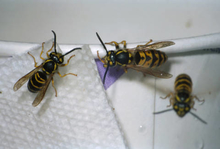
- They capture insects and spiders to feed their young.
- This can include pests like caterpillars, flies and crickets.
- Adults feed on sugar such as the juices of ripening and overripe fruits and honeydew (a sugary substance secreted by certain insects, like aphids).
- During late summer and fall, some yellowjackets become aggressive scavengers around human food and can be common outdoors where food or drinks are available.
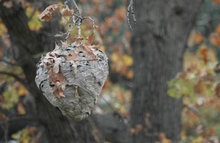
Where they nest
- They make nests from a papery pulp made of chewed-up wood fibers mixed with saliva.
- Their nests are made up of a series of rounded combs stacked in tiers.
- These combs are covered by an envelope made up of several layers of pulp.
- Yellowjackets build nests below ground in old rodent burrows or similar cavities.
- They can also build their nests in other cavities, such as hollow logs, landscape timbers and in buildings in attics and wall voids.
- Other yellowjackets, including baldfaced hornets, build aerial nests out in open places in trees and under eaves of buildings.
- Several hundred to several thousand yellowjackets and baldfaced hornets may be found inside their nests.
- Nests are used for just one season and will remain vacant the next season.
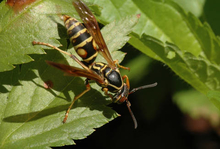
- Paper wasps (Polistes spp.) are slender with long legs (1/2 to 1 inch long) that dangle beneath their bodies when they fly.
- Generally brown with yellowish markings.
- European paper wasps are black and yellow in color and resemble yellow jackets.

What they eat
- They capture insects and spiders to feed their young. Including caterpillars, flies and crickets.
- Adults feed on sugar such as the juices of ripening and overripe fruits and honeydew (a sugary substance secreted by certain insects).
- Paper wasps also feed on the nectar of flowers.
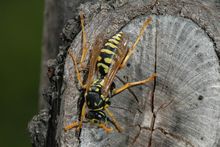
Where they nest
- Paper wasps build their nests with a papery pulp.
- They construct only one comb of cells without any protective envelope.
- They are sometimes called "umbrella wasps" because of the shape of their nest.
- They build nests under any horizontal surface and are commonly found on limbs, overhangs, building eaves, beams and supports in attics, garages, barns, sheds and similar places.
- Paper wasp nests are generally small and may have less than a dozen individuals. At most, about 100 wasps may be found in a nest.
- Like yellowjackets, paper wasps do not reuse nests the following year.
- Honey bees (Apis mellifera) have wings that lay flat and unfolded atop their abdomen when they are not flying.
- Approximately ½" long.
- Golden brown with thin black stripes on their abdomen.
- Fuzzy in appearance; the thorax especially is covered with branched hairs.
- Part of each hind leg is flattened for collecting pollen.
What they eat
- They feed only on nectar (carbohydrates) and pollen (protein) from flowers.
- Honey bees are sometimes found visiting bird baths, puddles and similar sources for water.
Where they nest
- Honey bees make a series of vertical honeycombs made of wax.
- Their colonies mostly occupy manufactured hives.
- They occasionally nest in cavities in large trees, voids in building walls, or other protected areas.
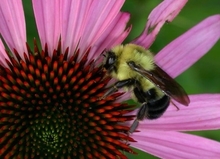
There are many different bumble bee species common in the Midwest. Most bumble bees (Bombus spp.) have the following characteristics:
- Range in size from less than 1/2 to 1 inch.
- Very fuzzy in appearance.
- Most species are black and yellow coloration although some species may be other colors.
- Roundish shape.
What they eat
They feed only on nectar (carbohydrates) and pollen (protein) from flowers.
Where they nest
- Bumble bee colonies are often located underground in deserted rodent nests or other cavities, in compost piles, and underneath objects on the ground.
- Some species will nest higher up in trees or wall cavities as well as in birdhouses and bird nests.
- Like honey bees, bumble bees construct cells made of wax.
Wasp and bee life cycles
All wasps and bees have a complete life cycle with egg, larval, pupal and adult stages. We generally see only the adults as the eggs and larvae are in the nests. The larvae of bees and wasps are white and typically look like grubs.
|
- Yellowjacket and paper wasp colonies survive only one year, referred to as an annual colony.
- Queens are the only members of the colony that survive the winter.
- Newly produced and mated queens leave their old nests and search for protected sites to spend the winter (under loose tree bark, old rotten stumps, or within buildings, such as under siding).
Spring and summer
- As the weather gets warmer in April or May, each queen becomes active. The queens select a suitable location and start to construct their nests.
- Each nest is built from scratch each year while the previous year's nests are not reused (except for European paper wasp nests).
- Queens start laying eggs and begin raising workers (sterile female offspring) as soon as possible.
- The workers then look for food and care for the young while the queen produces more eggs.
- The queen lays a single egg in each hexagonal nest cell.
- Once the egg hatches, the adults feed the larva chewed insects.
- Before larvae transform into pupae, the larvae spin white silken caps over their cells.
- A single paper wasp queen or several queens may start a nest.
- If a group of females start a nest, one becomes dominant and becomes responsible for laying eggs.
- The others assume duties for maintaining the nest and are joined later by newly produced workers.
- If the founding queen is killed, another queen will take over laying eggs.
Late summer through winter
- By late summer, new queens and males are produced.
- The colonies start declining as the queens stop laying eggs.
- Eventually, new queens are produced.
- After mating, they fly off to search for places to spend the winter.
- The nest remains active until freezing temperatures (usually in the mid to upper 20°s F) kill the old queen and the workers.
- In the Upper Midwest, yellowjacket and paper wasp nests do not survive the winter, even inside a building.
- When new queens find shelter in buildings for the winter, they remain in those sites until the weather becomes warm enough for them to become active.
- They emerge from their shelters in late winter or early spring.
- While yellowjacket queens live through the winter by themselves, paper wasp queens live in groups.
- If you see them indoors, they are not coming from an active nest, but from a shelter.
- You can physically remove them or crush them.
- You can also capture them and release them outdoors.
Bumble bees also have annual nests.
Spring
- Each new bumble bee queen selects a nest site and starts a new colony.
- She may line the cavity with dry grass or moss (depending on the species) and then collects pollen and nectar to produce a stored food called "bee bread."
- Her first brood of offspring, 5 to 20, will all be workers (daughters) who take over the colony responsibilities of nest enlargement, food gathering and storage, and feeding and caring for the larvae.
- The queen continues to lay eggs throughout the summer.
Late summer to fall
By late summer, new reproductive males and females (drones and queens) are produced.
- After mating, fertilized females move to hibernation sites underground or possibly in the shelter of loose bark to lie dormant through the winter.
- The males and workers still in the colony die with the first hard freeze.
- Honey bees are perennial insects with colonies that survive more than one year.
- Workers and queens survive the winter by forming a cluster when hive temperatures approach 57° F.
- Bees inside this mass consume honey and generate heat so that those in the cluster do not freeze.
- With sufficient honey available in the nest, a strong colony can withstand temperatures down to -30° F or lower for extended periods.
Swarms

- When colonies get too crowded, they swarm.
- A colony produces a new queen and the old queen takes off with many of her workers.
- Swarming usually occurs in late spring and early summer and begins in the warmer hours of the day.
- Swarms may contain several hundred to several thousand worker bees, a few drones and one queen.
- Swarming bees fly around briefly and then cluster on a tree limb, shrub or other object where they usually remain stationary for an hour to a few days, depending on weather and the time needed to find a new nest site by scouting bees.
- When a suitable location is found for a new colony, such as a hollow tree, the cluster breaks up and flies to it.
- Honey bee swarms are not dangerous under most circumstances.
- In most situations, honey bee swarms can be ignored. They are temporary and the bees will move off their own. Stay back and keep others away from the swarm.
- Only if a serious health threat is present because of the location of the swarm, such as in a highly traveled public area, should you need to do anything with a cluster.
An experienced beekeeper may be willing to gather a swarm and relocate it for you. To find a beekeeper that is willing to remove a honey bee colony or swarm in Iowa, Minnesota, and Wisconsin, visit this bee removal website. If the honey bees are in Minnesota, another option is to look for a beekeeper on the Minnesota Hobby Beekeepers Association website.
Wasp and bee stings
Social wasps and bees sting to defend their colony. Some yellow jacket species can also become aggressive during late summer and fall and may sting unprovoked.
Most people have only minor reactions to wasp stings, but a few may experience more serious allergic reactions.
|
Yellow jackets, paper wasps and bumble bees can sting more than once because they can pull out their stinger without injuring themselves. If you are stung by one of these insects, the stinger is not left in your skin.
Honey bees have tiny barbs on their stinger that remain hooked in the skin. The stinger, which is connected to the digestive system of the bee, is torn out of the abdomen as the bee attempts to fly away. As a result, the bee soon dies.
If you are stung by a honey bee, scratch out the stinger (with its attached venom gland) with your fingernail as soon as possible. Do not try to pull out the stinger between two fingers. Doing so only forces more venom into your skin, causing greater irritation.
Visit the Bee Lab for more information on bee and wasp stings.
Nonallergic reactions
Local, nonallergic reactions range from burning, itching, redness and tenderness to massive swelling and itching that may last up to a week.
Treat these local reactions with ice or commercial topical ointment to relieve the itching.
Non life-threatening allergic reactions
An allergic reaction may include hives or rash, swelling away from the sting site, headache, minor respiratory symptoms, and stomach upset.
These allergic reactions are not life-threatening and can be readily treated with an antihistamine. However, if this occurs, seek medical attention.
Life-threatening allergic reactions
Very rarely, a person may suffer a life-threatening, systemic allergic reaction to a bee or wasp sting, which can cause anaphylactic shock (fainting, difficulty breathing, swelling, and blockage in the throat) within minutes of being stung.
These systemic symptoms are cause for immediate medical attention. People with known systemic allergic reactions to bee or wasp stings should consult with their physician to obtain an Epi-Pen™ or Ana-Guard Sting Kit™ to carry with them at all times.
The venom of bees and wasps are different, so having a severe reaction to a bee sting does not automatically mean a person will have the same reaction to a yellow jacket or paper wasp sting.
Controlling unwanted nests
There are a wide range of options to control nests depending on their location and the time of year.
|
These insects are very protective of their nests and will sting to protect them.
If the location of the nest is out of the way, ignore it. If a nest is located in a high traffic area such as along walkways or near doorways, you may want to take control measures to reduce the threat of being stung.
If a yellowjacket or paper wasp nest is present and you want to get rid of it:
- Treat the nest during late evening or early morning when the yellowjackets are less active. The chances of being stung are less.
- Wear protective clothing (long-sleeved shirt and trousers) and tie sleeves and pants legs shut or pull your socks out over your pant cuffs.
- If after a day there is still activity (yellow jackets or paper wasps are still flying back and forth), repeat the treatment.
- You can also hire a pest management professional to deal with a wasp nest. They have the experience and the appropriate tools to expertly remove nests.
DO NOT attempt to manage a nest yourself if you are allergic to stings.
If a nest can be ignored until freezing temperatures arrive (usually in the mid to upper 20°s F), the cold will kill all of the workers and the queen.
Exposed nests
If you can see the nest (such as when attached to the eaves), you can treat it using an aerosol spray labeled for wasps and hornets or something similar.
- These contain active ingredients such as tetramethrin or prallethrin.
- For yellowjackets, spray it directly into the opening of the nest where they fly back and forth.
- For paper wasps, spray them so all of the combs receive some pesticide.
- It is also possible to kill paper wasps with a soap and water mixture.
Yellowjacket ground nests
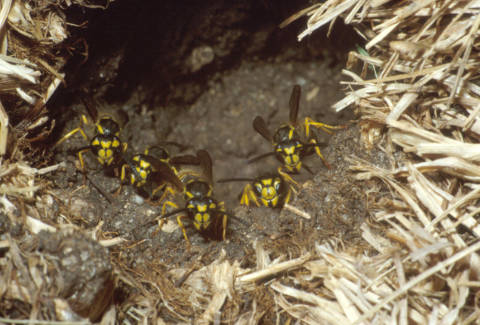
- Nests in the ground can be controlled by placing an insecticide dust in and around the nest entrance during the night.
- Permethrin is the active ingredient in insecticide dust. The dust particles will stick to the insects as they leave and re-enter the nest and they should be controlled within a few days.
- Pouring a liquid pesticide into the nest entrance is not as effective as the above methods. Liquid might not reach the nest depending on where it is located within the burrow.
Hidden yellowjacket nests
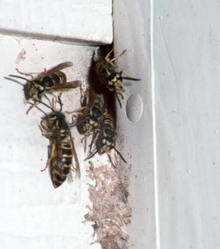
Yellowjacket nests that are found inside homes in wall voids, attics, concrete blocks or similar spaces are much more challenging to control. It's usually best for a pest management professional to control hidden nests in buildings.
If you wish to take steps yourself:
- The most effective treatment is to apply of a dust containing deltamethrin. Not many products like this are available to the general public.
- An aerosol pesticide is NOT very effective. An aerosol spray can sometimes cause yellow jackets to look for another way out, which often leads them to the inside of homes.
- DO NOT seal the nest opening until you know all of the yellowjackets are dead as this can also cause yellowjackets to move into your house.
Honey bee nests
Honey bee colonies are not usually found in buildings. Their nests may last for many years.
If you think you have a honey bee nest inside, capture a bee or take a good picture and get it identified to verify what insect you actually have.
If the specimens are confirmed to be honey bees, first consider contacting a beekeeper for help with removal of the colony. An experienced beekeeper may be willing to gather a swarm and relocate it for you.
To find a beekeeper that is willing to remove a honey bee colony or swarm in Iowa, Minnesota or Wisconsin, visit this bee removal website. If the honey bees are in Minnesota, you can look for a beekeeper on the Minnesota Hobby Beekeepers Association website.
Using insecticides
If it is not possible to save a honey bee colony, then it may be necessary to treat it with an insecticide.
If possible, wait until early spring, March to April. At that time the colony may be either dead or will have little honey left. If the colony is still active, this is the best time to treat the honey bees and remove the nest.
Even if honey combs cannot be removed, chances are there will be very little honey left in combs by April. By late April or early May honey bees start collecting nectar again, so there is a narrow window of time to remove them when there is little to no honey.
Any remaining wax should not be a problem as wax moths usually destroy it quickly and then are gone. But any combs and honey left behind can cause a problem from bees from other colonies, scavenging insects and mice.
Do not save these honey combs or honey if the colony was treated with insecticide.
Bumble bee nests
If the area around a bumble bee nest can be avoided, leave them alone and wait for them to die in the fall. Most species are not aggressive unless you reach directly into the nest or accidentally step on it. Some common species are only active until early August with the rest ending activity in September.
Put up a little fence around the nest to help prevent accidents. Live-trapping bumble bees for relocation is not practical and covering the nest entrance does not usually solve the problem. Relocating the entire nest also is not practical as often the colony does not survive.
Bumble bee nests in yards, flower beds, wood piles, walls or other areas where a lot of human activity occurs may create a nuisance. If there is a high risk of stings and the area cannot be avoided, it may be necessary to treat the nest.
One out of every three bumble bee species is in decline. It is important to protect these declining species when possible. Before treating any bumble bee nest, make sure that the bumble bee species is not federally protected due to risk of extinction.
The rusty-patched bumble bee is listed as endangered under the Endangered Species Act. Unless you have received a permit, it is illegal to harass, harm, kill, trap, capture or collect the rusty-patched bumble bee. Anyone who violates the Endangered Species Act may be assessed a civil penalty (e.g., fine) for each violation.
- Take a photo of the bumble bee. Confirm that it is NOT a rusty-patched bumble bee or other species of conservation concern (Use Guide to Minnesota bumble bees).
- Find the exact location of the nest entrance from a safe distance during the day.
- Wait until night to treat if possible.
- Wear a long-sleeved shirt and trousers and tie sleeves and pant legs shut or pull your socks out over your pant cuffs.
- Use a soapy water solution (about 1/4 cup of laundry or dish soap to one gallon of water).
- If using an insecticide, treat the same as when treating ground-nesting yellow jackets.
Nuisance yellowjackets
|
Yellowjackets and other social wasps are found in large numbers in late summer and fall. The wasps are present since spring, but because colonies start as a single queen, populations are very small through the early part of the summer.
Yellowjacket populations peak during late summer when each nest may have up to approximately 5,000 wasps. Some yellowjacket species become aggressive scavengers and can disrupt outside activities where food or drink are served.
Controlling yellowjackets
- Control of scavenging yellowjackets is difficult, as there are no effective pesticides to keep them away.
- It is possible to spray soapy water on individual yellowjackets to kill them.
- The best strategy is to minimize attracting them.
- Wait to serve food and drink until people are ready to eat.
- Promptly put away food when done and throw garbage into a container with a tight-fitting lid.
- Examine glasses, cans and other containers before drinking from them to check for yellowjackets that may have flown inside. If a yellowjacket flies into your food, wait for it to fly away or gently brush it away.
- If there are only a few yellowjackets, ignore them. You could also capture them with a net and crush them.
- You can use traps, but traps are able to catch only a very small number of wasps.
Authors: Jeffrey Hahn, former Extension entomologist; Laura Jesse, Iowa State University; and Patrick Liesch, University of Wisconsin
Reviewed in 2020
How to Get Rid of Bees Nest in Wall Cavity
Source: https://extension.umn.edu/yard-and-garden-insects/wasps-and-bees
0 Response to "How to Get Rid of Bees Nest in Wall Cavity"
Post a Comment